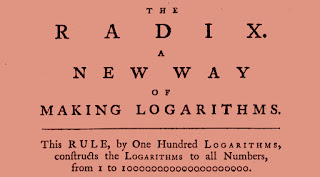How to obtain decimal logarithms and antilogarithms on the abacus
 | |
| Cover from Robert Flower's The Radix. A New Way of Making Logarithms (London 1771) |
- Import logarithms from an external table or calculator.
- Obtain logarithms directly.
The first option is the practical one, the one that has been used for centuries, but has the drawback of making the work with the abacus trivial and unattractive to the 21st century abacist. On the other hand, the purist might complain about using external resources.
The second option, interesting in itself, represents an extraordinary amount of work, which is why many people in the past spent decades of their lives building tables of logarithms to simplify the work of others.
Fortunately, there is a third way that is intermediate between the previous two: the Radix method, which allows obtaining logarithms and antilogarithms of any number using a very reduced external data table and with a reasonable amount of work. Also, this method will be attractive to the abacist who will spend most of his time using two special methods, namely: multiplication and division by numbers slightly greater than one...
By the way, this type of algorithm is the one that was implemented in the ROM of the famous scientific calculator of the 70's the HP 35, the killer of the slide rule!
Please, read the complete article in jccAbacus Web.



No comments:
Post a Comment